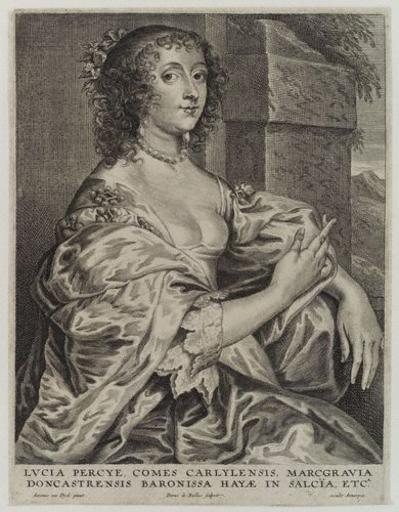MAKE A MEME
View Large Image

| View Original: | Lucy_Percy,_Countess_of_Carlisle.jpg (390x500) | |||
| Download: | Original | Medium | Small | Thumb |
| Courtesy of: | www.flickr.com | More Like This | ||
| Keywords: london, st martin's place, wc2 0he londonstmartinsplacewc20he united kingdom unitedkingdom drawing indoor ancient sketch Lucy Hay, Countess of Carlisle (1599 – 5 November 1660) was an English courtier known for her beauty and wit. She was involved in many political intrigues during the English Civil War. She was born Lucy Percy, the second daughter of the 9th Earl of Northumberland, the famous "Wizard Earl." She became the second wife of James Hay, 1st Earl of Carlisle. Her charms were celebrated in verse by contemporary poets, including Thomas Carew, William Cartwright, Robert Herrick and John Suckling, and by Sir Toby Matthew in prose. She was a conspicuous figure at the court of King Charles I. A contemporary scandal made her the mistress successively of Thomas Wentworth, 1st Earl of Strafford, and of John Pym, his parliamentary opponent. Strafford valued her highly, but after his death, possibly in consequence of a revulsion of feeling at his abandonment by the court, she devoted herself to Pym and to the interests of the parliamentary leaders, to whom she communicated the king's most secret plans and counsels. Her greatest achievement was the timely disclosure to Robert Devereux, 3rd Earl of Essex of the king's intended arrest of the five members of Parliament, which enabled Essex to escape. However, she appears to have served both parties simultaneously, betraying communications on both sides, and doing considerable mischief by inflaming political animosities. In 1647, she attached herself to the interests of the moderate Presbyterian party, which assembled at her house, and in the Second Civil War showed great zeal and activity in the royal cause, pawning her pearl necklace for £1500 to raise money for Lord Holland's troops, establishing communications with Prince Charles during his blockade of the Thames, and making herself the intermediary between the scattered bands of royalists and the queen. As a result, her arrest was ordered on 21 March 1649, and she was imprisoned in the Tower of London, where she maintained a correspondence in code with the king through her brother, Lord Percy, until Charles went to Scotland. According to a royalist newsletter, while in the Tower she was threatened with torture on the rack to gain information. She was released on bail on 25 September 1650, but appears never to have regained her former influence in the royalist counsels, and died soon after the Restoration. Alexandre Dumas probably based Milady in his The Three Musketeers on Lucy Hay. by; after Pieter de Bailliu the Younger; Sir Anthony Van Dyck,print,circa 1700-1725 Lucy Hay, Countess of Carlisle (1599 – 5 November 1660) was an English courtier known for her beauty and wit. She was involved in many political intrigues during the English Civil War. She was born Lucy Percy, the second daughter of the 9th Earl of Northumberland, the famous "Wizard Earl." She became the second wife of James Hay, 1st Earl of Carlisle. Her charms were celebrated in verse by contemporary poets, including Thomas Carew, William Cartwright, Robert Herrick and John Suckling, and by Sir Toby Matthew in prose. She was a conspicuous figure at the court of King Charles I. A contemporary scandal made her the mistress successively of Thomas Wentworth, 1st Earl of Strafford, and of John Pym, his parliamentary opponent. Strafford valued her highly, but after his death, possibly in consequence of a revulsion of feeling at his abandonment by the court, she devoted herself to Pym and to the interests of the parliamentary leaders, to whom she communicated the king's most secret plans and counsels. Her greatest achievement was the timely disclosure to Robert Devereux, 3rd Earl of Essex of the king's intended arrest of the five members of Parliament, which enabled Essex to escape. However, she appears to have served both parties simultaneously, betraying communications on both sides, and doing considerable mischief by inflaming political animosities. In 1647, she attached herself to the interests of the moderate Presbyterian party, which assembled at her house, and in the Second Civil War showed great zeal and activity in the royal cause, pawning her pearl necklace for £1500 to raise money for Lord Holland's troops, establishing communications with Prince Charles during his blockade of the Thames, and making herself the intermediary between the scattered bands of royalists and the queen. As a result, her arrest was ordered on 21 March 1649, and she was imprisoned in the Tower of London, where she maintained a correspondence in code with the king through her brother, Lord Percy, until Charles went to Scotland. According to a royalist newsletter, while in the Tower she was threatened with torture on the rack to gain information. She was released on bail on 25 September 1650, but appears never to have regained her former influence in the royalist counsels, and died soon after the Restoration. Alexandre Dumas probably based Milady in his The Three Musketeers on Lucy Hay. by; after Pieter de Bailliu the Younger; Sir Anthony Van Dyck,print,circa 1700-1725 | ||||